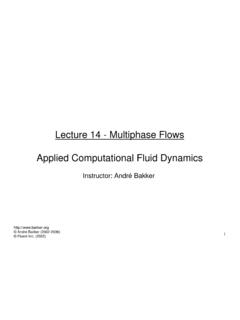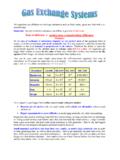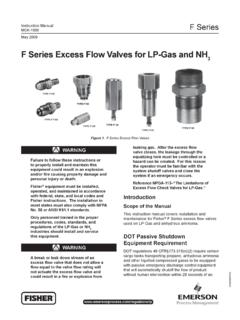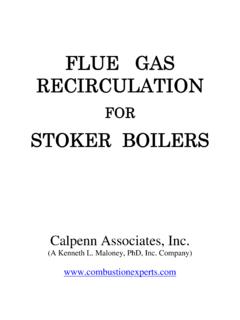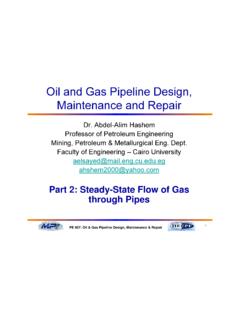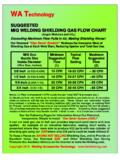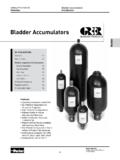Transcription of White Paper: Application of the Orifice Meter for Accurate ...
1 Application of the Orifice Meter for Accurate gas flow Measurementpage 1 DANIEL MEASUREMENT AND CONTROL White PAPERS ummaryThe most common device used in gas flow measurement is the Orifice flow Meter . It is capable of very Accurate measurement provided it is properly applied, designed, installed, maintained and interpreted. It is the intention of this article to cover these aspects of the Orifice Meter so that the use of the device can be evaluated and a proper decision made on most Accurate measurement, the Orifice Meter should be applied to gas flows , which are steady or vary slowly with time, is in the turbulent flow region, and is well below sonic velocity. The gas should be single phase and not contain suspended particles. If the gas temperature is above or below the ambienttemperature consideration may be given to insulating the upstream and downstream tubes and the lead lines to the recording devices or transducers.
2 If flow changes are large (such as over 5 to 1 turn down) and slow with time (such asseasonal load changes) provision should be made to change orifices to provide a good differential at all rates. Availability of sufficient permanent pressure loss is a requirement for any head-measuring device and must be considered in its Application . The coefficient of discharge of an Orifice is determined empirically so that the particular Orifice Meter being installed must reproduceas closely as possible the installation on which the tests were run whether they be specific tests on the unit itself or general tests run by the various standards agencies. These agencies have detailed requirements of installation that have been determined while running a number of calibrations over the years. In each case deviation from the test installations may introduce errors so that a complete understanding of these requirements is necessary before changes from these standards are readout equipment on the differential across the Orifice and the other variables such as density, pressure, temperature, specific gravity, composition, heating value (depending on the method of measurement and quantity units required) must be properly installed, operated, to obtain Accurate gas flow measurement.
3 This is also true of the taps to the flowing stream and the sample lines running to each piece of equipment. Proper calculation from the measured variable is required and depending on the flowing characteristics one system of readout may be advantageous to this introduction, examples will show the kind of problems that can exist if the above precautions are not have been many papers and standards written on the basic theory of the Orifice covering every aspect. However, when a metering device is being considered for an operating location these additional factors should be Properties of the GasThe Accurate calculation of flow through an Orifice requires a correct differential pressure and a correct density of the flowing gas and proper interpretation of their effects on the performance on the flow pattern across the plate is very important for flow measurement accuracy.
4 There are tow factors which control this pattern -- piping configuration, including length, roundness, smoothness, and nearest fitting (such as elbows, valves, tees). The second is the Reynolds Number, which is the guide to the shape, size and stability of the vena contracta. Fortunately, mostnatural gas is handled at relatively high Reynolds Numbers (above 10,000) so that it seldom is a matter of the internal viscous forces becoming a major component of the predominate inertial forces. Because of this, the high Reynolds Number range is the range that the coefficient becomes stabilized. A generalrange that is accepted is 10,000 for the area ration plates in smaller runs and 200,000 for the .56 area ratio plate in larger runs. Below these values the coefficient changes rapidly and the square edge concentric Orifice has a rapidly increasing tolerance on its use.
5 Note: Area ration equals square of beta gas changes its density as it passes through an Orifice and this is corrected for by an expansion factor. The higher the differential pressure ranges the greater the density change for a given static pressure. We have developed factors for this correction up to a Mach number of .75; however, best accuracy is obtained if .2 of the velocity of sound in the gas at flowing conditions is used as a limit. This condition is met if the differential in inches of water does not exceed the pressure in pounds per square inch absolute. This will keep the correction factor in the range of 1% and small errors due to Application of a of the Orifice Meter for Accurate gas flow Measurementpage 2 DANIEL MEASUREMENT AND CONTROL White PAPER value based on average conditions will be of the major sources of error in the Application of an Orifice is the problem of taking the square root of the differential measurement and the effects of small errors in the differential at low differentials.
6 As an example, an error of .5 inches ( cm) on a 100 inch (254 cm) manometer represents a .23% error or flow, at 75 inches (190 cm) a .33% of flow error but at 10 inches( cm) a flow practice then dictates that the differential be kept as high as possible within the limitations of the strength of the Orifice , the range of the flow fluctuation, the range of the differential device and the limitations on the expansion differential error combined with the error in the static pressure measurement at low pressures makes the Orifice less Accurate and have less range since we restrict the differential range by the .2 Mach number in the temperature have a small effect on flow accuracies for most natural gas since the absolute ambient temperature range of measurement causes approximately .2% error in flow rate per degree centigrade gravities make about.
7 1% error in flow for each .001 error in reading and this can introduce fairly good size errors on gases with changing compositions unless this measurement is integrated into the volume calculation rather than averaged over a time compressibility factor of natural gas (which corrects for the ratio of actual volume to ideal volume) is roughly a .5% correction in volume per 100 psi of pressure at usual measuring conditions. Hence, an error of several per cent in factor is only a small error in volume. However, if the gas is reduced near its critical point correction factors as much as 225% are required and small errors in measured variables are reflected as large errors in volume. Likewise, gases with large concentrations of non-hydrocarbon gases in their mixtures are difficult to calculate accurately, since little data is available on these mixtures.
8 Some of theoretical values obtained by the pseudo - critical method based on the mixture composition have shown errors of several percent when compared with empirically determined test data on the same gas. This problem becomes more pronounced as the percentage of methane is reduced. If the value of the product handled is sufficient, then compressibility tests are recommended for confirmation of the theoretical data to the tolerances a specific weight device (commercially referred to as densitometer) is used, the calculation of flow rate is simplified, and the number of sources of errors reduced. These have only recently begun to be used to any extent, however, assuming an Accurate device, the mathematical calculation of volume can beimproved and the accuracy tolerance reduced. The usual four variables: Temperature, Pressure, Specific Gravity, and Compressibility are reduced to one, density if mass is being measured, or two density and specific gravity if volume is the unit of measurement each of the cases sighted on errors of the measured variables there are two sources which cause errors: one, the measurement of the variable, and secondly, the conversion of the measurement to a mass or volume by use of the flow ElementsWhile the Orifice plate is the most inexpensive item in the entire measurement station it is the most important part, as its physical condition can be largely responsible for the overall accuracy of the measurement.
9 Therefore, it is of extreme importance to manufacture the Orifice plate in accordance with the tolerances recommended by the American Gas Association Gas Measurement Committee Report Number Three and the International Organization for Standardization Recommendation 541. It is of equal importance that the Orifice plate be handled with care and a regular inspection routine should be instigated to insure the maximum quality of the condition of the plate at all should be set up on a regular routine so that the Orifice plate can be examined for any changes from its initial condition. If the inspector finds any conditions to exist that were not present originally that can not be corrected by cleaning, the Orifice plate should be removed from the line and replaced with a new Orifice plate, as this particular item is inexpensive and readily availablefrom most any manufacturer s stock.
10 The importance of a regular routine inspection of this portion of the primary element cannot be stressed Orifice plate must be properly centered and housed, and this is done with the Orifice fitting or flange. There are but a few basic types of Orifice fittings, and the primary function of each of these is to hold the Orifice plate concentrically in the line so that the differential pressure can be measured properly and also to facilitate removing the Orifice plate for periodic changing or of the Orifice Meter for Accurate gas flow Measurementpage 3 Orifice Plate HoldersThere are other styles of plate holding devices that offer easier access to the Orifice plate. One style of plate holding device requires the loosening of several set screws from the top of the fitting and the Orifice plate is removed from the line by lifting out the sealing bar, as the Orifice plate and carrier are bolted to this sealing bar.










